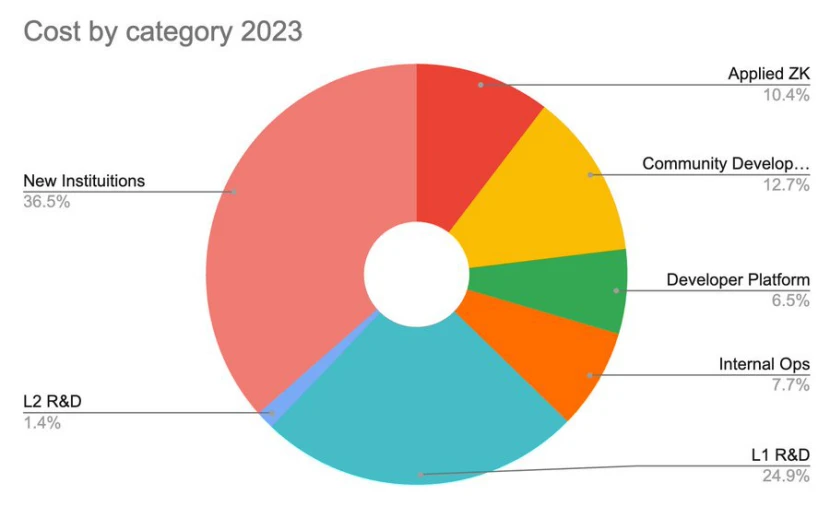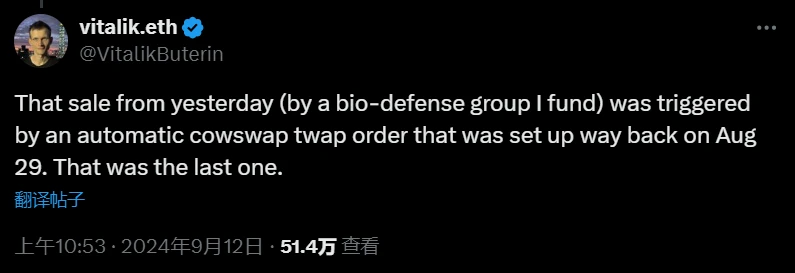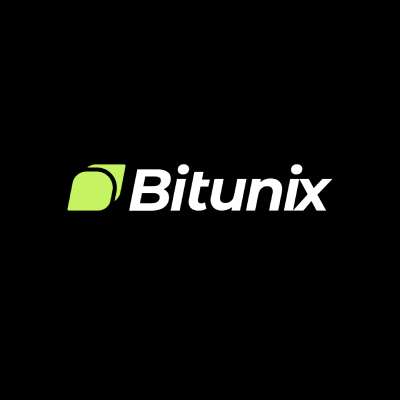Ethereum находится под большим давлением. Как Виталик и Фонд реагируют на сомнения?
Ethereum Foundation reveals spending

Recently, the Ethereum Foundation’s sale of ETH and its fund transparency have attracted widespread attention in the crypto community. In response, the Ethereum Foundation announced its official expenditures at the end of August.
According to the chart, new institutions accounted for the largest share of foundation spending, at 36.5%. Vitalik Buterin said that this category includes grants to various organizations, such as the Nomic Foundation, L2 BEAT, Decentralized Research Center, and 0x PARC Foundation, and the main goal of building these new organizations is to strengthen the Ethereum community in the long term.
The second largest spending category of the Foundation is L1 RD, accounting for 24.9% of total spending. This category includes funding for external customer teams (62%) and internal Foundation researchers (38%). Internal spending includes teams such as Geth, Cryptography Research, Devcon, Solidity, Next Billion, etc. The responsibilities of these teams are public, and there is relevant activity information on their websites, github, and social channels.
In addition, the foundation has published activity reports on external expenditures or funding in the past four years. Projects funded by the foundation in Q1 2024 include Xerxis, Ethereum Bogota, Motherless Africa, ETHKL, etc. The rest of the foundations expenditures include community development (12.7%), zero-knowledge applications (10.4%), internal operations (7.7%), developer platforms (6.5%), and L2 research and development (1.4%).
In addition to revealing the Ethereum Foundation’s expenses, Vitalik also revealed that his annual salary at the organization is about $139,500. This is not high compared to his net worth, which Forbes estimated at about $1.5 billion in 2022.
Regarding the Ethereum Foundations fund management plan, Vitalik mentioned that the foundation will spend 15% of the remaining funds each year, which means that the foundation will exist forever, but its influence in the ecosystem will decrease over time. Foundation member Justin Drake expects that the foundation will still have about 10 years of operating funds, but this will fluctuate with the price of ETH.
Vitalik sells ETH again?

Vitalik was criticized again after selling $441,000 worth of ETH on September 12, but he explained that the order was placed in August and said that it was the last sale (to fund ecological defense projects) and no similar transactions were expected. It is reported that the transaction was triggered by the Cowswap twap automatic order, which was set as early as August 29 (the twap strategy can execute large orders by spreading large orders into smaller parts over a certain period of time).
According to LookOnChain data, wallets associated with Vitalik sold a total of 190 ETH on September 12, and have sold $2.28 million worth of ETH since August 30. In this regard, Vitalik insisted that he never profited from the sale of ETH because all the proceeds were used to fund the project, which was silent.
What do Vitalik and the Ethereum Foundation think of DeFi?
Long-time DeFi developer Kain Warwick recently accused Vitalik and the Ethereum Foundation of being “anti-DeFi.” The developer claimed that the Foundation only spends a small portion of its budget each year to promote the development of the decentralized finance sector and wastes the vast majority of its annual budget on other unimportant things.
Vitalik responded by emphasizing his long-term focus on decentralized exchanges and sustainable projects, and reiterated his commitment to the field of decentralized finance, but he is not interested in investing in short-term projects with unsustainable prospects, such as liquidity mining or temporary projects that rely on issuing new tokens and then selling them on the market.
Dankrad Feist, a member of the Ethereum Foundation team, said that the Foundation does not have a unified view on DeFi. He personally likes DeFi, but DeFi cannot solve all of Ethereums problems alone. The financial market itself does not create value, but it can create more value for society by providing services such as liquidity and insurance. DeFis most valuable contribution on Ethereum is decentralized stablecoins. He hopes that these stablecoins can become a pure medium of exchange for cryptocurrencies, but they have serious expansion limitations, so custody solutions are more popular now. Despite this, he believes that it is very valuable to have a decentralized, censorship-free alternative.
The main directions of the Ethereum Foundations recent research
Despite its controversial spending, the Ethereum Foundation is actively working on technological advancements in multiple areas.
Regarding zero-knowledge proof (ZK), George Kadianakis said that research on STARKs and SNARKs is being used, such as recursive signature aggregation and achieving post-quantum security. Justin Drake mentioned that the introduction of SNARKs has significantly reduced the cost of proof, and emphasized the formal verification work of zkEVM.
Regarding the Verifiable Delay Function (VDF), Antonio Sanso said that although it has not yet been implemented in Ethereum, the team is studying its potential applications, but it needs further improvement and evaluation.
Regarding Maximum Extractable Value (MEV), Barnabé Monnot and s 0 isp 0 ke discussed the research progress of solutions such as ePBS, Execution Tickets, and Inclusion Lists to reduce the impact of MEV and improve the networks anti-censorship capabilities.
Vitalik Buterin and Justin Drake believe that binary hash trees may be used instead of Verkle trees in the future to adapt to technology upgrades. In addition, formal verification and verifiable computing are seen as key technologies to ensure code correctness and promote interoperability between different programs.
How does the Foundation view the issue of ETH value accumulation?
As we all know, according to the roadmap, rollups form a diverse ecosystem on Ethereum L1, there are a large number of DApps on L2, and the fees paid by users are extremely low, but this involves the problem of the lack of value accumulation of ETH assets. Regarding this issue, members of the Ethereum Foundation believe that the value accumulation of ETH is crucial to the success of Ethereum. ETH as a currency supports decentralized stablecoins and provides economic security for the network.
Justin Drake, a member of the foundation, believes that Ethereum must become the programmable currency of the Internet, and the value accumulation of ETH will be realized through total fees and currency premium. It is the total fee that is important, not the fee per transaction. Even if the fee per transaction is less than one cent, billions of dollars in revenue can still be generated through 10 million transactions per second.
Another important aspect he mentioned is the proportion of ETH used as collateral currency, such as supporting DeFi. Different financial activities on Ethereum will bring value capture to ETH.
In addition, he also believes that in the Rollup roadmap, the Ethereum mainnet will be the intersection of high-value activities, and L1 expansion is necessary.
If Ethereum is designed to facilitate sustainable economic activity, the value accumulation of ETH will follow. The growth of ETHs value will support the security and economic activity of the Ethereum ecosystem, thereby promoting Ethereum to become a global financial platform.
How to deal with the centralization problem of Layer 2?
Currently, more than 80% of Ethereum transactions occur on Layer 2 solutions, including Arbitrum, Optimism, Base, and zkSync. L2 networks have also faced some criticism recently for their centralization. Last month, Justin Bons of Cyber Capital raised concerns that these networks pose risks due to their centralization. In response, Vitalik explained that highly decentralized L2 solutions are essentially unable to take away users funds without reaching a strong consensus.
On September 12, Vitalik said that he would only publicly acknowledge L2 that has reached Stage 1 or higher in decentralized work, regardless of whether he invests in it or not. Vitalik reiterated his emphasis on L2 and emphasized the importance of security, suggesting that initial protections should not be removed until the proof system is thoroughly verified. Starting next year, he plans to only publicly mention (such as in public occasions such as blogs, speeches, etc.) L2 that is at Stage 1 or higher, and provide a possibly short grace period for truly interesting new projects.
Vitalik outlined the criteria for Stage 1+ rollup, which requires a 75% consensus from the council to overturn the proof system, and at least 26% of the council members must be independent of the rollup team. He believes that this requirement is reasonable and necessary for the security of the network. The era of rollup being glorified as multi-signature is coming to an end, and the era of encrypted trust has arrived. It is reported that several zero-knowledge (ZK) rollup teams plan to achieve this milestone by the end of this year.
краткое содержание
In summary, although Ethereum is facing some FUD, the Ethereum team is still actively facing and solving the problem. As the largest public application chain, the fundamentals of Ethereum have not been shaken, and there is no need to be overly pessimistic.
The biggest problem of Ethereum at present is that industry applications have encountered a bottleneck period, but the low handling fee of L2 is brewing and promoting the outbreak of new applications. After the lack of liquidity in the capital market improves, the adoption rate of the crypto industry will accelerate, and the future of Ethereum is still worth looking forward to.
This article is sourced from the internet: Ethereum is under great pressure. How do Vitalik and the Foundation respond to the doubts?
Related: The latest remarks sparked controversy. Does Vitalik really understand DeFi?
Original author: Alex Liu, Foresight News The allegations against Vitalik Vitalik Buterin’s controversial views on DeFi came from a post in which he responded to a thread accusing him of poor communication on the topic of DeFi . The post read: “Vitalik, I think one of the reasons people are confused or frustrated about your views on DeFi is because of miscommunication: It seems that in your opinion, DeFi is the mining craze and Ponzi scheme in 2021 ; but for many others (I would say most people), DeFi means saving and borrowing money on Money Рынокs such as Aave, CDPs such as RAI (which you also mentioned!), Synthetics, etc. These are all healthy decentralized financial applications – income comes from borrowers, transaction fees, etc. (Editors note: CDP, collateralized debt…







